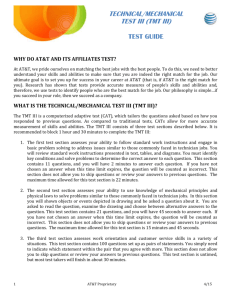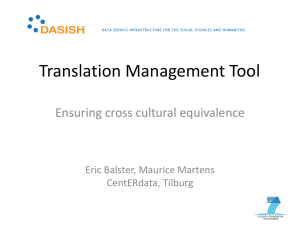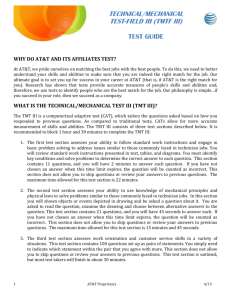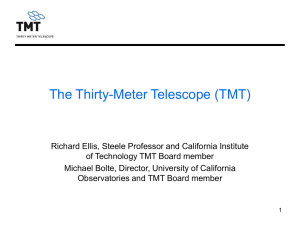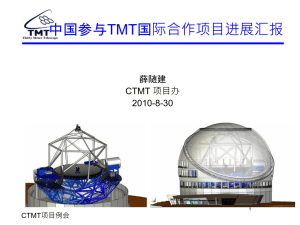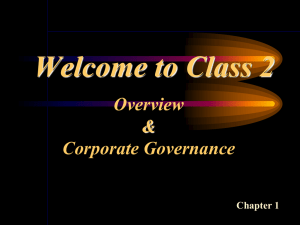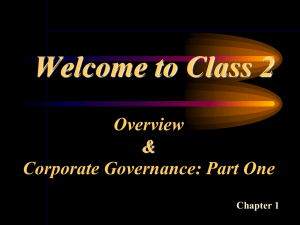TMT Partnership Principles
advertisement
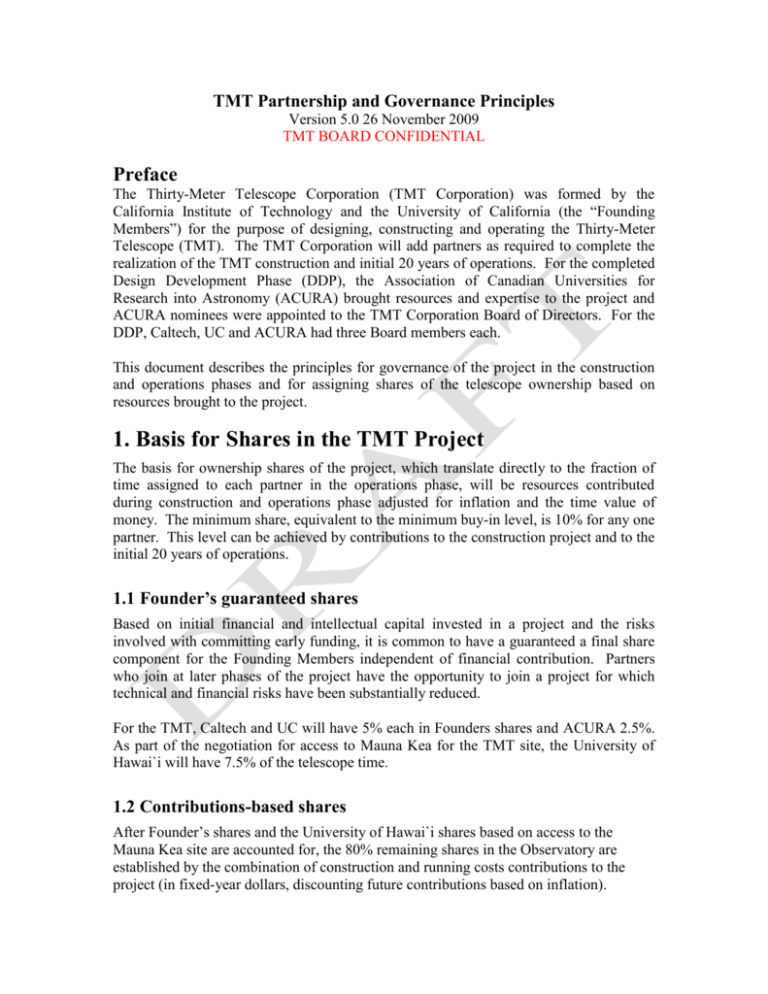
TMT Partnership and Governance Principles Version 5.0 26 November 2009 TMT BOARD CONFIDENTIAL Preface The Thirty-Meter Telescope Corporation (TMT Corporation) was formed by the California Institute of Technology and the University of California (the “Founding Members”) for the purpose of designing, constructing and operating the Thirty-Meter Telescope (TMT). The TMT Corporation will add partners as required to complete the realization of the TMT construction and initial 20 years of operations. For the completed Design Development Phase (DDP), the Association of Canadian Universities for Research into Astronomy (ACURA) brought resources and expertise to the project and ACURA nominees were appointed to the TMT Corporation Board of Directors. For the DDP, Caltech, UC and ACURA had three Board members each. This document describes the principles for governance of the project in the construction and operations phases and for assigning shares of the telescope ownership based on resources brought to the project. 1. Basis for Shares in the TMT Project The basis for ownership shares of the project, which translate directly to the fraction of time assigned to each partner in the operations phase, will be resources contributed during construction and operations phase adjusted for inflation and the time value of money. The minimum share, equivalent to the minimum buy-in level, is 10% for any one partner. This level can be achieved by contributions to the construction project and to the initial 20 years of operations. 1.1 Founder’s guaranteed shares Based on initial financial and intellectual capital invested in a project and the risks involved with committing early funding, it is common to have a guaranteed a final share component for the Founding Members independent of financial contribution. Partners who join at later phases of the project have the opportunity to join a project for which technical and financial risks have been substantially reduced. For the TMT, Caltech and UC will have 5% each in Founders shares and ACURA 2.5%. As part of the negotiation for access to Mauna Kea for the TMT site, the University of Hawai`i will have 7.5% of the telescope time. 1.2 Contributions-based shares After Founder’s shares and the University of Hawai`i shares based on access to the Mauna Kea site are accounted for, the 80% remaining shares in the Observatory are established by the combination of construction and running costs contributions to the project (in fixed-year dollars, discounting future contributions based on inflation). Shares will be based on the commitment of funding for construction and running costs and confirmed at the formation of the partnership. Although the partnership must identify all the construction and running costs, it is not required that a partner contribute equal shares of the construction and operations costs. 1.2.1 Time value of resources contributed to the project I’m still unclear on how we justify this outside of the investment value of money. At the November Board meeting we agreed to a simple table of decreasing value of money with time in three or four categories (after correction for inflation). Phase $ in DDP+EC units DDP and Construction Operations Second Gen Instrumentation contributions 1.0 0.8 0.7 1.2.2 In-kind contributions Contributions to the project can be made as cash or as contracted deliverables of the construction project. The latter will be referred to as in-kind contributions. 10% of the contributions will go to a Common Fund in support of centralized project management, systems engineering, business office function and other centralized project functions. 20% will go to an Infrastructure Fund to support construction of roads, conventional buildings and site improvement. Up to the 70% remaining of any partner’s total can made as in-kind contributions. All in-kind contributions will be defined as work packages, be approved in advance by the Project Office and be managed by the Project. The value of major work packages will be set by the Project based on critically-reviewed, detailed cost estimates. Work package values will be calculated in US dollars using the rate of exchange on the day the work package is signed. 2. Post-First-Generation Instruments and other Observatory Improvements The priority for post-first-generation capabilities and the science-driven requirements for new instruments will be established by the Science Advisory Committee. A baseline level of funding for new capabilities, proposed to be ~$5M/year, will be included in the 20-year operations commitment. Telescope time for a fixed term will be made available in exchange for additional instrument funding or provided instruments. TMT Partners will have first priority in bidding for new instrument projects; however, new instrument programs will not be restricted to the partners. The “exchange rate” of telescope time assigned will be less for resources committed to second-generation instruments and beyond than for the original capital project. 3. Governance structure 1.3 Board responsibilities The TMT Board will provide the primary forum for interactions between the partners. The TMT Board will have overall budgetary and policy control of the TMT Observatory. The Board will define and appoint such committees as it deems necessary and will establish the Observatory management structure. The Board will be responsible for reviewing and approving the annual Observatory budget. Designation of Board members will be made by the appropriate official of each partner. For the University of California and Caltech, the appointments will be made by the President of UC and Caltech respectively. 1.4 Board membership The TMT Board of Directors will have voting members from each of the partners. The Board structure includes an executive committee composed of the Chair and Vice Chair. For the TMT DDP, the members of the TMT Corporation each appointed three Directors to the Board. The Chair and Vice Chair of the Board were from the Founding Members. Each Director had an equal vote and decisions were by majority rules. For the construction and operations phases of the project, it is anticipated that there will be partners with varying levels of “shares” in the project. The “proportional representation” model will be continued into the construction and operations phase of the project. One Board position will be generated for each 10% share in the Observatory. (need rounding rule described here). Initially, the Board Chair and Vice Chair positions will be rotated between CIT, UC and ACURA with no institution concurrently filling the Chair and Vice Chair positions. The executive Board positions will be filled for a term of three years. 1.5 Board voting model For the construction and operations phases of the TMT each Board member will have one vote and decisions will be made based on majority rules. 1.6 Other governance structures There will be a TMT Scientific Advisory Committee (SAC) that provides advice on scientific matters, including prioritization of new capabilities for the Observatory. Membership on the SAC will be established following the partner membership on the TMT Board of Directors. 4. Management Structure The TMT Board will have overall responsibility for fiscal and policy issues of the TMT Observatory. For the management of the construction project, the Board will appoint a Project Manager, who will be accountable to and report directly to the TMT Board. In the operations phase of the Observatory the Board will appoint an Observatory Director who will be accountable to and report directly to the TMT Board. The primary responsibilities of this individual will be: Direct the operation of the Keck Observatory so as to maximize its readiness and effectiveness for scientific research. Recruit and maintain a cadre of high quality technical and administrative staff motivated to support the scientific mission of the observatory. Develop the annual budget for review and approval by the CARA Board. With input from the Science Advisory Committee, develop and keep current both short-range and long-range plans for the Observatory to include: maintenance of existing capabilities and prospects, plans for instrumentation, upgrades to Observatory facilities and staff and budget projections. 5. Other Issues 1.7 Ownership Who owns facilities and equipment? 1.8 Case where partner leaves partnership The UK/Gemini recent example demonstrates that we need a policy for premature withdrawal. Appendix A Complete capital plan Operations (running costs) plan Appendix B Major in-kind capital contributions by partner
